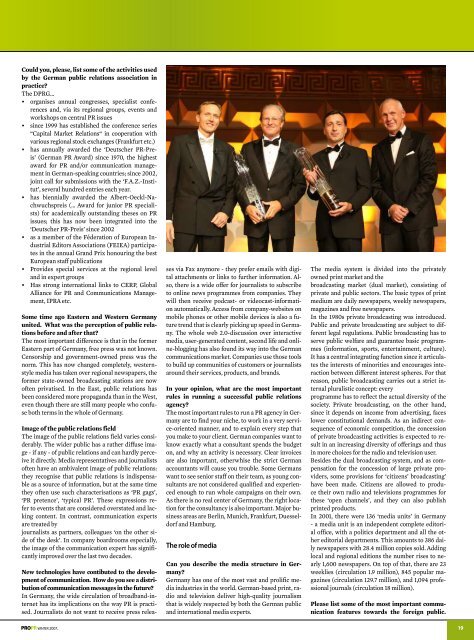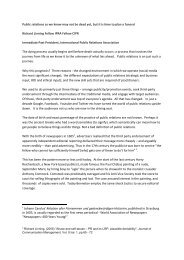CASE STUDY Pfizer's PR campaign „Openly about sex“ - PRO.PR
CASE STUDY Pfizer's PR campaign „Openly about sex“ - PRO.PR
CASE STUDY Pfizer's PR campaign „Openly about sex“ - PRO.PR
You also want an ePaper? Increase the reach of your titles
YUMPU automatically turns print PDFs into web optimized ePapers that Google loves.
Could you, please, list some of the activities used<br />
by the German public relations association in<br />
practice?<br />
The D<strong>PR</strong>G…<br />
• organises annual congresses, specialist conferences<br />
and, via its regional groups, events and<br />
workshops on central <strong>PR</strong> issues<br />
• since 1999 has established the conference series<br />
“Capital Market Relations“ in cooperation with<br />
various regional stock exchanges (Frankfurt etc.)<br />
• has annually awarded the ‘Deutscher <strong>PR</strong>-Preis’<br />
(German <strong>PR</strong> Award) since 1970, the highest<br />
award for <strong>PR</strong> and/or communication management<br />
in German-speaking countries; since 2002,<br />
joint call for submissions with the ‘F.A.Z.-Institut’,<br />
several hundred entries each year.<br />
• has biennially awarded the Albert-Oeckl-Nachwuchspreis<br />
(… Award for junior <strong>PR</strong> specialists)<br />
for academically outstanding theses on <strong>PR</strong><br />
issues; this has now been integrated into the<br />
‘Deutscher <strong>PR</strong>-Preis’ since 2002<br />
• as a member of the Féderation of European Industrial<br />
Editors Associations (FEIEA) participates<br />
in the annual Grand Prix honouring the best<br />
European staff publications<br />
• Provides special services at the regional level<br />
and in expert groups<br />
• Has strong international links to CERP, Global<br />
Alliance for <strong>PR</strong> and Communications Management,<br />
I<strong>PR</strong>A etc.<br />
Some time ago Eastern and Western Germany<br />
united. What was the perception of public relations<br />
before and after that?<br />
The most important difference is that in the former<br />
Eastern part of Germany, free press was not known.<br />
Censorship and government-owned press was the<br />
norm. This has now changed completely, westernstyle<br />
media has taken over regional newspapers, the<br />
former state-owned broadcasting stations are now<br />
often privatised. In the East, public relations has<br />
been considered more propaganda than in the West,<br />
even though there are still many people who confuse<br />
both terms in the whole of Germany.<br />
Image of the public relations field<br />
The image of the public relations field varies considerably.<br />
The wider public has a rather diffuse image<br />
- if any - of public relations and can hardly perceive<br />
it directly. Media representatives and journalists<br />
often have an ambivalent image of public relations:<br />
they recognise that public relations is indispensable<br />
as a source of information, but at the same time<br />
they often use such characterisations as ‘<strong>PR</strong> gags’,<br />
‘<strong>PR</strong> pretence’, ‘typical <strong>PR</strong>’. These expressions refer<br />
to events that are considered overstated and lacking<br />
content. In contrast, communication experts<br />
are treated by<br />
journalists as partners, colleagues ‘on the other side<br />
of the desk’. In company boardrooms especially,<br />
the image of the communication expert has significantly<br />
improved over the last two decades.<br />
New technologies have contibuted to the development<br />
of communication. How do you see a distribution<br />
of communication messages in the future?<br />
In Germany, the wide circulation of broadband-internet<br />
has its implications on the way <strong>PR</strong> is practised.<br />
Journalists do not want to receive press relea-<br />
<strong>PR</strong>O<strong>PR</strong> winter 2007.<br />
ses via Fax anymore - they prefer emails with digital<br />
attachments or links to further information. Also,<br />
there is a wide offer for journalists to subscribe<br />
to online news programmes from companies. They<br />
will then receive podcast- or videocast-information<br />
automatically. Access from company-websites on<br />
mobile phones or other mobile devices is also a future<br />
trend that is clearly picking up speed in Germany.<br />
The whole web 2.0-discussion over interactive<br />
media, user-generated content, second life and online-blogging<br />
has also found its way into the German<br />
communications market. Companies use those tools<br />
to build up communities of customers or journalists<br />
around their services, products, and brands.<br />
In your opinion, what are the most important<br />
rules in running a successful public relations<br />
agency?<br />
The most important rules to run a <strong>PR</strong> agency in Germany<br />
are to find your niche, to work in a very service-oriented<br />
manner, and to explain every step that<br />
you make to your client. German companies want to<br />
know exactly what a consultant spends the budget<br />
on, and why an activity is necessary. Clear invoices<br />
are also important, otherwhise the strict German<br />
accountants will cause you trouble. Some Germans<br />
want to see senior staff on their team, as young consultants<br />
are not considered qualified and experienced<br />
enough to run whole <strong>campaign</strong>s on their own.<br />
As there is no real center of Germany, the right location<br />
for the consultancy is also important. Major business<br />
areas are Berlin, Munich, Frankfurt, Duesseldorf<br />
and Hamburg.<br />
The role of media<br />
Can you describe the media structure in Germany?<br />
Germany has one of the most vast and prolific media<br />
industries in the world. German-based print, radio<br />
and television deliver high-quality journalism<br />
that is widely respected by both the German public<br />
and international media experts.<br />
The media system is divided into the privately<br />
owned print market and the<br />
broadcasting market (dual market), consisting of<br />
private and public sectors. The basic types of print<br />
medium are daily newspapers, weekly newspapers,<br />
magazines and free newspapers.<br />
In the 1980s private broadcasting was introduced.<br />
Public and private broadcasting are subject to different<br />
legal regulations. Public broadcasting has to<br />
serve public welfare and guarantee basic programmes<br />
(information, sports, entertainment, culture).<br />
It has a central integrating function since it articulates<br />
the interests of minorities and encourages interaction<br />
between different interest spheres. For that<br />
reason, public broadcasting carries out a strict internal<br />
pluralistic concept: every<br />
programme has to reflect the actual diversity of the<br />
society. Private broadcasting, on the other hand,<br />
since it depends on income from advertising, faces<br />
lower constitutional demands. As an indirect consequence<br />
of economic competition, the concession<br />
of private broadcasting activities is expected to result<br />
in an increasing diversity of offerings and thus<br />
in more choices for the radio and television user.<br />
Besides the dual broadcasting system, and as compensation<br />
for the concession of large private providers,<br />
some provisions for ‘citizens’ broadcasting’<br />
have been made. Citizens are allowed to produce<br />
their own radio and televisions programmes for<br />
these ‘open channels’, and they can also publish<br />
printed products.<br />
In 2001, there were 136 ‘media units’ in Germany<br />
- a media unit is an independent complete editorial<br />
office, with a politics department and all the other<br />
editorial departments. This amounts to 386 daily<br />
newspapers with 28.4 million copies sold. Adding<br />
local and regional editions the number rises to nearly<br />
1,600 newspapers. On top of that, there are 23<br />
weeklies (circulation 1.9 million), 845 popular magazines<br />
(circulation 129.7 million), and 1,094 professional<br />
journals (circulation 18 million).<br />
Please list some of the most important communication<br />
features towards the foreign public.<br />
1



